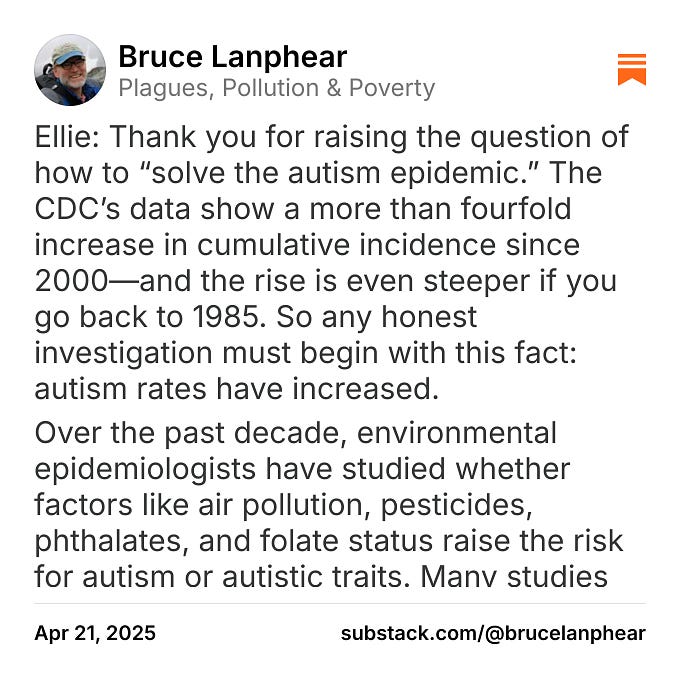epiellie.substack.com/p/how-to-solve-the-autism-epidemic/comment/110921405
Preview meta tags from the epiellie.substack.com website.
Linked Hostnames
2Thumbnail

Search Engine Appearance
Bruce Lanphear on E is for Epi
Ellie: Thank you for raising the question of how to “solve the autism epidemic.” The CDC’s data show a more than fourfold increase in cumulative incidence since 2000—and the rise is even steeper if you go back to 1985. So any honest investigation must begin with this fact: autism rates have increased. Over the past decade, environmental epidemiologists have studied whether factors like air pollution, pesticides, phthalates, and folate status raise the risk for autism or autistic traits. Many studies have found strong associations. Now we face the harder question: when is the evidence sufficient to draw conclusions—or to advise pregnant women to reduce exposure? That’s not a simple matter. We’re not dealing with a single drug that can be banned. These are widespread, everyday exposures. Air pollution, pesticides, and plasticizers are embedded in how we live—and that makes regulation difficult. Understandably, agencies are reluctant to label them hazardous when there’s no easy way to eliminate them.
Bing
Bruce Lanphear on E is for Epi
Ellie: Thank you for raising the question of how to “solve the autism epidemic.” The CDC’s data show a more than fourfold increase in cumulative incidence since 2000—and the rise is even steeper if you go back to 1985. So any honest investigation must begin with this fact: autism rates have increased. Over the past decade, environmental epidemiologists have studied whether factors like air pollution, pesticides, phthalates, and folate status raise the risk for autism or autistic traits. Many studies have found strong associations. Now we face the harder question: when is the evidence sufficient to draw conclusions—or to advise pregnant women to reduce exposure? That’s not a simple matter. We’re not dealing with a single drug that can be banned. These are widespread, everyday exposures. Air pollution, pesticides, and plasticizers are embedded in how we live—and that makes regulation difficult. Understandably, agencies are reluctant to label them hazardous when there’s no easy way to eliminate them.
DuckDuckGo
Bruce Lanphear on E is for Epi
Ellie: Thank you for raising the question of how to “solve the autism epidemic.” The CDC’s data show a more than fourfold increase in cumulative incidence since 2000—and the rise is even steeper if you go back to 1985. So any honest investigation must begin with this fact: autism rates have increased. Over the past decade, environmental epidemiologists have studied whether factors like air pollution, pesticides, phthalates, and folate status raise the risk for autism or autistic traits. Many studies have found strong associations. Now we face the harder question: when is the evidence sufficient to draw conclusions—or to advise pregnant women to reduce exposure? That’s not a simple matter. We’re not dealing with a single drug that can be banned. These are widespread, everyday exposures. Air pollution, pesticides, and plasticizers are embedded in how we live—and that makes regulation difficult. Understandably, agencies are reluctant to label them hazardous when there’s no easy way to eliminate them.
General Meta Tags
16- titleComments - How to solve the autism epidemic: Step 1
- title
- title
- title
- title
Open Graph Meta Tags
9- og:urlhttps://epiellie.substack.com/p/how-to-solve-the-autism-epidemic/comment/110921405
- og:typearticle
- og:titleBruce Lanphear on E is for Epi
- og:descriptionEllie: Thank you for raising the question of how to “solve the autism epidemic.” The CDC’s data show a more than fourfold increase in cumulative incidence since 2000—and the rise is even steeper if you go back to 1985. So any honest investigation must begin with this fact: autism rates have increased. Over the past decade, environmental epidemiologists have studied whether factors like air pollution, pesticides, phthalates, and folate status raise the risk for autism or autistic traits. Many studies have found strong associations. Now we face the harder question: when is the evidence sufficient to draw conclusions—or to advise pregnant women to reduce exposure? That’s not a simple matter. We’re not dealing with a single drug that can be banned. These are widespread, everyday exposures. Air pollution, pesticides, and plasticizers are embedded in how we live—and that makes regulation difficult. Understandably, agencies are reluctant to label them hazardous when there’s no easy way to eliminate them.
- og:imagehttps://substackcdn.com/image/fetch/w_680,h_680,c_limit,f_auto,q_auto:good,fl_progressive:steep/https%3A%2F%2Fsubstack.com%2Fnote%2Fc-110921405%2Fpreview.jpeg%3Fsize%3Dsm
Twitter Meta Tags
8- twitter:label1Likes
- twitter:data10
- twitter:label2Replies
- twitter:data20
- twitter:titleBruce Lanphear on E is for Epi
Link Tags
53- alternate/feed
- apple-touch-iconhttps://substackcdn.com/image/fetch/f_auto,q_auto:good,fl_progressive:steep/https%3A%2F%2Fsubstack-post-media.s3.amazonaws.com%2Fpublic%2Fimages%2F4a66aa19-a078-4965-8dd7-43a9f0a312ee%2Fapple-touch-icon-57x57.png
- apple-touch-iconhttps://substackcdn.com/image/fetch/f_auto,q_auto:good,fl_progressive:steep/https%3A%2F%2Fsubstack-post-media.s3.amazonaws.com%2Fpublic%2Fimages%2F4a66aa19-a078-4965-8dd7-43a9f0a312ee%2Fapple-touch-icon-60x60.png
- apple-touch-iconhttps://substackcdn.com/image/fetch/f_auto,q_auto:good,fl_progressive:steep/https%3A%2F%2Fsubstack-post-media.s3.amazonaws.com%2Fpublic%2Fimages%2F4a66aa19-a078-4965-8dd7-43a9f0a312ee%2Fapple-touch-icon-72x72.png
- apple-touch-iconhttps://substackcdn.com/image/fetch/f_auto,q_auto:good,fl_progressive:steep/https%3A%2F%2Fsubstack-post-media.s3.amazonaws.com%2Fpublic%2Fimages%2F4a66aa19-a078-4965-8dd7-43a9f0a312ee%2Fapple-touch-icon-76x76.png
Links
14- https://epiellie.substack.com
- https://epiellie.substack.com/p/how-to-solve-the-autism-epidemic/comment/110921405
- https://epiellie.substack.com/p/how-to-solve-the-autism-epidemic/comments#comment-110921405
- https://substack.com
- https://substack.com/@brucelanphear/note/c-110921405